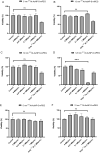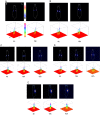Intratumoral administration of astatine-211-labeled gold nanoparticle for alpha therapy
- PMID: 34320997
- PMCID: PMC8317303
- DOI: 10.1186/s12951-021-00963-9
Intratumoral administration of astatine-211-labeled gold nanoparticle for alpha therapy
Abstract
Background: 211At is a high-energy α-ray emitter with a relatively short half-life and a high cytotoxicity for cancer cells. Its dispersion can be imaged using clinical scanners, and it can be produced in cyclotrons without the use of nuclear fuel material. This study investigated the biodistribution and the antitumor effect of 211At-labeled gold nanoparticles (211At-AuNP) administered intratumorally.
Results: AuNP with a diameter of 5, 13, 30, or 120 nm that had been modified with poly (ethylene glycol) methyl ether (mPEG) thiol and labeled with 211At (211At-AuNP-S-mPEG) were incubated with tumor cells, or intratumorally administered to C6 glioma or PANC-1 pancreatic cancers subcutaneously transplanted into rodent models. Systemic and intratumoral distributions of the particles in the rodents were then evaluated using scintigraphy and autoradiography, and the changes in tumor volumes were followed for about 40 days. 211At-AuNP-S-mPEG was cytotoxic when it was internalized by the tumor cells. After intratumoral administration, 211At-AuNP-S-mPEG became localized in the tumor and did not spread to systemic organs during a time period equivalent to 6 half-lives of 211At. Tumor growth was strongly suppressed for both C6 and PANC-1 by 211At-AuNP-S-mPEG. In the C6 glioma model, the strongest antitumor effect was observed in the group treated with 211At-AuNP-S-mPEG with a diameter of 5 nm.
Conclusions: The intratumoral single administration of a simple nanoparticle, 211At-AuNP-S-mPEG, was shown to suppress the growth of tumor tissue strongly in a particle size-dependent manner without radiation exposure to other organs caused by systemic spread of the radionuclide.
Keywords: Alpha emitters; Astatine-211; Cancer therapy; Gold nanoparticles; Radiolabeling.
© 2021. The Author(s).
Conflict of interest statement
The author(s) have no potential competing of interest to declare with respect to the conduct of the research, the authorship, and/or the publication of this article.
Figures






Similar articles
-
Local Radiation Treatment of HER2-Positive Breast Cancer Using Trastuzumab-Modified Gold Nanoparticles Labeled with 177Lu.Pharm Res. 2017 Mar;34(3):579-590. doi: 10.1007/s11095-016-2082-2. Epub 2016 Dec 16. Pharm Res. 2017. PMID: 27987070
-
Intratumorally Injected 177Lu-Labeled Gold Nanoparticles: Gold Nanoseed Brachytherapy with Application for Neoadjuvant Treatment of Locally Advanced Breast Cancer.J Nucl Med. 2016 Jun;57(6):936-42. doi: 10.2967/jnumed.115.168906. Epub 2016 Feb 4. J Nucl Med. 2016. PMID: 26848176
-
Multimeric system of 99mTc-labeled gold nanoparticles conjugated to c[RGDfK(C)] for molecular imaging of tumor α(v)β(3) expression.Bioconjug Chem. 2011 May 18;22(5):913-22. doi: 10.1021/bc100551s. Epub 2011 May 3. Bioconjug Chem. 2011. PMID: 21513349
-
211At on gold nanoparticles for targeted radionuclide therapy application.Phys Chem Chem Phys. 2024 May 1;26(17):12915-12927. doi: 10.1039/d3cp05326a. Phys Chem Chem Phys. 2024. PMID: 38629229 Review.
-
Realizing Clinical Trials with Astatine-211: The Chemistry Infrastructure.Cancer Biother Radiopharm. 2020 Aug;35(6):425-436. doi: 10.1089/cbr.2019.3055. Epub 2020 Feb 20. Cancer Biother Radiopharm. 2020. PMID: 32077749 Free PMC article. Review.
Cited by
-
The Current Status and Future Directions on Nanoparticles for Tumor Molecular Imaging.Int J Nanomedicine. 2024 Sep 14;19:9549-9574. doi: 10.2147/IJN.S484206. eCollection 2024. Int J Nanomedicine. 2024. PMID: 39296941 Free PMC article. Review.
-
Therapeutic efficacy of 211At-radiolabeled 2,6-diisopropylphenyl azide in mouse models of human lung cancer.Chem Sci. 2023 Jun 27;14(30):8054-8060. doi: 10.1039/d3sc02513f. eCollection 2023 Aug 2. Chem Sci. 2023. PMID: 37538829 Free PMC article.
-
Radiation nanomedicines for cancer treatment: a scientific journey and view of the landscape.EJNMMI Radiopharm Chem. 2024 May 4;9(1):37. doi: 10.1186/s41181-024-00266-y. EJNMMI Radiopharm Chem. 2024. PMID: 38703297 Free PMC article. Review.
-
Optical magnetic multimodality imaging of plectin-1-targeted imaging agent for the precise detection of orthotopic pancreatic ductal adenocarcinoma in mice.EBioMedicine. 2022 Jun;80:104040. doi: 10.1016/j.ebiom.2022.104040. Epub 2022 May 4. EBioMedicine. 2022. PMID: 35525203 Free PMC article.
-
177Lu-Gold Nanohybrids in Radiotherapeutic Approaches Against Cancer.Small Sci. 2024 Dec 12;5(5):2400550. doi: 10.1002/smsc.202400550. eCollection 2025 May. Small Sci. 2024. PMID: 40395357 Free PMC article. Review.
References
-
- Smith GD, Pickles T, Crook J, Martin AG, Vigneault E, Cury FL, Morris J, Catton C, Lukka H, Warner A, et al. Brachytherapy improves biochemical failure-free survival in low- and intermediate-risk prostate cancer compared with conventionally fractionated external beam radiation therapy: a propensity score matched analysis. Int J Radiat Oncol Biol Phys. 2015;91:505–516. doi: 10.1016/j.ijrobp.2014.11.018. - DOI - PubMed
-
- Roddiger SJ, Kolotas C, Filipowicz I, Kurek R, Kuner RP, Martin T, Baltas D, Rogge B, Kontova M, Hoffmann G, et al. Neoadjuvant interstitial high-dose-rate (HDR) brachytherapy combined with systemic chemotherapy in patients with breast cancer. Strahlenther Onkol. 2006;182:22–29. doi: 10.1007/s00066-006-1454-7. - DOI - PubMed
MeSH terms
Substances
Grants and funding
LinkOut - more resources
Full Text Sources
Other Literature Sources
Research Materials

